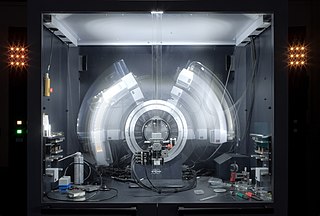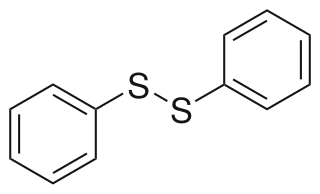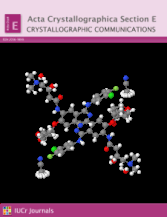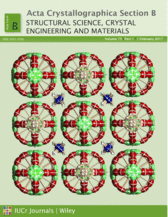
X-ray crystallography is the experimental science of determining the atomic and molecular structure of a crystal, in which the crystalline structure causes a beam of incident X-rays to diffract in specific directions. By measuring the angles and intensities of the X-ray diffraction, a crystallographer can produce a three-dimensional picture of the density of electrons within the crystal and the positions of the atoms, as well as their chemical bonds, crystallographic disorder, and other information.
Jack David Dunitz FRS was a British chemist and widely known chemical crystallographer. He was Professor of Chemical Crystallography at the ETH Zurich from 1957 until his official retirement in 1990. He held Visiting Professorships in the United States, Israel, Japan, Canada, Spain and the United Kingdom.

Mercury(II) sulfate, commonly called mercuric sulfate, is the chemical compound HgSO4. It is an odorless salt that forms white granules or crystalline powder. In water, it separates into an insoluble basic sulfate with a yellow color and sulfuric acid.

Tin(II) sulfate (SnSO4) is a chemical compound. It is a white solid that can absorb enough moisture from the air to become fully dissolved, forming an aqueous solution; this property is known as deliquescence. It can be prepared by a displacement reaction between metallic tin and copper(II) sulfate:

Diphenyl disulfide is the chemical compound with the formula (C6H5S)2. This colorless crystalline material is often abbreviated Ph2S2. It is one of the more commonly encountered organic disulfides in organic synthesis. Minor contamination by thiophenol is responsible for the disagreeable odour associated with this compound.

The Cambridge Crystallographic Data Centre (CCDC) is a non-profit organisation based in Cambridge, England. Its primary activity is the compilation and maintenance of the Cambridge Structural Database, a database of small molecule crystal structures. They also perform analysis on the database for the benefit of the scientific community, and write and distribute computer software to allow others to do the same.
Acta Crystallographica is a series of peer-reviewed scientific journals, with articles centred on crystallography, published by the International Union of Crystallography (IUCr). Originally established in 1948 as a single journal called Acta Crystallographica, there are now six independent Acta Crystallographica titles:

Acta Crystallographica Section E: Crystallographic Communications is an open-access structural communications journal. It reports crystal structure determinations of inorganic, metal-organic and organic compounds. Since 2012, Acta Crystallogr. E has not been included in the Science Citation Index.

Acta Crystallographica Section D: Structural Biology publishes articles covering all areas of structural biology, including biomolecular structures determined by NMR and cryo-EM as well as crystallography, and the methods used to obtain them. The journal was launched in 1993 as Acta Crystallographica Section D: Biological Crystallography with Jenny Glusker as the founding Editor. In 2003, Ted Baker and Zbigniew Dauter took over the editorship of the journal. The current Editors are Elspeth Garman, Randy J. Read and Charles S. Bond. In 2016, the title was changed to Acta Crystallographica Section D: Structural Biology to reflect the expanded scope of the journal.

Acta Crystallographica Section C: Structural Chemistry is a journal for the rapid publication of research with structural content relating to the chemical sciences.
A crystallographic database is a database specifically designed to store information about the structure of molecules and crystals. Crystals are solids having, in all three dimensions of space, a regularly repeating arrangement of atoms, ions, or molecules. They are characterized by symmetry, morphology, and directionally dependent physical properties. A crystal structure describes the arrangement of atoms, ions, or molecules in a crystal..

Acta Crystallographica Section A: Foundations and Advances is a peer-reviewed structural science journal published bimonthly by the International Union of Crystallography. It contains papers describing fundamental developments in structural science. It was founded in 1967 when Acta Crystallographica was split into two sections, and was initially titled Acta Crystallographica Section A: Crystal Physics, Diffraction, Theoretical and General Crystallography. The journal's name changed in 1982 to Acta Crystallographica Section A: Foundations of Crystallography. The journal adopted its current title in 2013.
Physical Review E is a peer-reviewed, scientific journal, published monthly by the American Physical Society. The main field of interest is collective phenomena of many-body systems. It is currently edited by Uwe C. Täuber. While original research content requires subscription, editorials, news, and other non-research content is openly accessible.

The Journal of Applied Crystallography is a peer-reviewed scientific journal published by Wiley-Blackwell on behalf of the International Union of Crystallography. It was established in 1968 with André Guinier as the founding editor. The journal covers the application of crystallography and crystallographic techniques. William Parrish (1914–1991) chaired the committee that started the journal.

Zeitschrift für Kristallographie – New Crystal Structures is a bimonthly peer-reviewed scientific journal published in English. Its first issue was published in December 1997 and bore the subtitle "International journal for structural, physical, and chemical aspects of crystalline materials." Created as a spin-off of Zeitschrift für Kristallographie for reporting novel and refined crystal structures, it began at volume 212 in order to remain aligned with the numbering of the parent journal. Paul von Groth, Professor of Mineralogy at the University of Strasbourg, established Zeitschrift für Krystallographie und Mineralogie in 1877; after several name changes, the journal adopted its present name, Zeitschrift für Kristallographie – Crystalline Materials, in 2010.
Robert Day Shannon is a retired research chemist formerly at DuPont de Nemours, Inc.
Hans-Beat Bürgi is a Swiss chemist and crystallographer. He was a professor for crystallography at the University of Bern from 1979 to 2007.
Alexander Frank Wells, or A. F. Wells, was a British chemist and crystallographer. He is known for his work on structural inorganic chemistry, which includes the description and classification of structural motifs, such as the polyhedral coordination environments, in crystals obtained from X-ray crystallography. His work is summarized in a classic reference book, Structural inorganic chemistry, first appeared in 1945 and has since gone through five editions. In addition, his work on crystal structures in terms of nets have been important and inspirational for the field of metal-organic frameworks and related materials.
Cadmium selenate is a selenate of cadmium, with the chemical formula CdSeO4.











